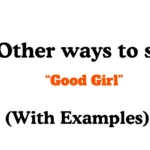When sending professional messages, mistakes happen—maybe a document was attached incorrectly, a date was updated, or new information replaced the old one. In such cases, using the right words to ask someone to ignore your earlier email is important. Instead of sounding abrupt, you can choose alternatives that are warm, professional, and considerate, ensuring your recipient feels respected and valued.
Below, you’ll find 30 thoughtful alternatives to say “Please Disregard My Previous Email”—each with scenarios, examples, tone, and explanation to help you express yourself with clarity and care.
What Does “Please Disregard My Previous Email” Mean?
The phrase “Please Disregard My Previous Email” is a polite way to tell someone that your earlier message contained errors, outdated details, or unnecessary content, and you’d like them not to act upon it.
Is It Professional/Polite to Say “Please Disregard My Previous Email”?
Yes—it is both professional and polite, but sometimes it may sound too direct or abrupt if not phrased carefully. Adding warmth and context can make your message feel more respectful and considerate while keeping things clear.
Pros or Cons
Pros:
- Clear and direct communication.
- Prevents confusion or missteps.
- Maintains accountability and transparency.
Cons:
- May sound curt or impersonal.
- Lacks warmth if repeated often.
- Can cause confusion if not paired with a corrected message.
Synonyms For “Please Disregard My Previous Email”
- Kindly ignore my previous email
- Please ignore my earlier message
- My apologies, please disregard the previous email
- Please refer to this email instead
- Disregard the last message and see below
- The previous email contained errors—please ignore
- Kindly consider this email as the correct version
- Please disregard the earlier information
- The earlier email was sent in error
- Please accept the corrected email below
- Please ignore my last email
- Apologies, the previous email was incorrect
- Please refer to this updated message
- The prior email was outdated—use this instead
- Please take this email as the final version
- Kindly overlook my previous email
- The earlier message is no longer valid
- Please consider this as the correct information
- Disregard the email sent earlier
- The previous email should be ignored
- Kindly disregard my earlier communication
- Please note that my previous email was incorrect
- The earlier email contained inaccuracies
- Please read this email instead
- Kindly accept this as the updated version
- The prior email was incomplete
- Please treat this as the correct update
- My earlier message was sent prematurely
- Please disregard the message before this
- Apologies for the confusion, this is the correct email
1. Kindly Ignore My Previous Email
Scenario: You realized your earlier message contained outdated meeting details.
Examples:
- Kindly ignore my previous email regarding tomorrow’s schedule—the updated details are attached here.
- Please kindly ignore my earlier note; the correct file is now included in this email.
- Kindly ignore the earlier message as it contained incorrect timings. See updated details below.
Tone: Polite, respectful, slightly formal.
Explanation: Adding “kindly” softens the directive and makes it feel courteous.
2. Please Ignore My Earlier Message
Scenario: You want to sound casual yet professional when retracting a message.
Examples:
- Please ignore my earlier message—the latest draft is attached here.
- That note was sent in error; please ignore my earlier message and refer to this one.
- Please ignore my earlier message as it did not have the final information.
Tone: Professional but approachable.
Explanation: Direct yet not too harsh—useful for routine communication.
3. My Apologies, Please Disregard the Previous Email
Scenario: You want to include an apology to show accountability.
Examples:
- My apologies, please disregard the previous email—it contained outdated information.
- Please accept my apologies and disregard the last email. This one has the correct data.
- I apologize for the confusion—please disregard the previous message.
Tone: Warm, responsible, professional.
Explanation: Combining apology with the request shows sincerity.
4. Please Refer to This Email Instead
Scenario: When you want to guide the recipient to the correct version.
Examples:
- Please refer to this email instead of the one I sent earlier.
- This email replaces the previous one—please refer to this version instead.
- Please refer to this email instead for the accurate update.
Tone: Professional, clear, solution-focused.
Explanation: Shifts focus away from the mistake and onto the correction.
5. Disregard the Last Message and See Below
Scenario: You caught an error quickly and want to redirect attention.
Examples:
- Disregard the last message and see below for the corrected information.
- Please disregard my previous note and see the updated details below.
- Disregard the last message; the final agenda is listed here.
Tone: Direct but helpful.
Explanation: A concise way to correct mistakes without over-apologizing.
6. The Previous Email Contained Errors—Please Ignore
Scenario: You need to clarify an error openly.
Examples:
- The previous email contained errors—please ignore it and use this one.
- Please note that the previous message had inaccuracies. Kindly disregard it.
- Please ignore the earlier email as it contained incorrect attachments.
Tone: Honest, transparent.
Explanation: Demonstrates professionalism and responsibility for mistakes.
7. Kindly Consider This Email as the Correct Version
Scenario: When sharing the finalized version of something important.
Examples:
- Kindly consider this email as the correct version of the proposal.
- Please disregard the earlier note and kindly consider this the updated report.
- This is the corrected version—kindly consider this as the accurate one.
Tone: Polite, formal.
Explanation: Acknowledges the error while giving importance to the correction.
8. Please Disregard the Earlier Information
Scenario: When specific information in the previous email was wrong.
Examples:
- Please disregard the earlier information about the meeting time; here are the correct details.
- Please ignore the earlier information I shared—it was outdated.
- Please disregard the earlier information and use the attached document instead.
Tone: Professional and corrective.
Explanation: Helps specify what to ignore without overexplaining.
9. The Earlier Email Was Sent in Error
Scenario: You sent an email unintentionally or too soon.
Examples:
- The earlier email was sent in error. Please disregard it and see this message instead.
- Please ignore the earlier message—it was sent in error before completion.
- The earlier email was mistakenly sent. Kindly disregard it.
Tone: Professional, explanatory.
Explanation: Shows accountability without over-apologizing.
10. Please Accept the Corrected Email Below
Scenario: You want to emphasize the corrected version of a message.
Examples:
- Please accept the corrected email below as the final version.
- Kindly accept this corrected version and disregard the one sent earlier.
- This corrected email should be referred to instead of my earlier one.
Tone: Polite, respectful.
Explanation: Positions the new email as reliable and trustworthy.
11. Please Ignore My Last Email
Scenario: You want to keep things short and professional.
Examples:
- Please ignore my last email; the updated version is attached.
- Kindly ignore my last email—it was incomplete.
- Please ignore my last email as it contained the wrong attachment.
Tone: Brief, polite, professional.
Explanation: Works well when you want a clear, simple correction without overexplaining.
12. Apologies, the Previous Email Was Incorrect
Scenario: When you need to admit a mistake respectfully.
Examples:
- Apologies, the previous email was incorrect. Please see the corrected details below.
- My apologies—the earlier message had errors. Please review this one instead.
- Apologies, the previous email contained outdated data. Kindly see the latest version here.
Tone: Warm, responsible, professional.
Explanation: Blends apology with correction for sincerity.
13. Please Refer to This Updated Message
Scenario: When the focus should be on the latest version.
Examples:
- Please refer to this updated message instead of the one sent earlier.
- This updated message replaces my previous note.
- Please ignore the older version and refer to this updated message.
Tone: Clear, forward-looking.
Explanation: Redirects attention away from the mistake toward the updated content.
14. The Prior Email Was Outdated—Use This Instead
Scenario: You sent details that are no longer valid.
Examples:
- The prior email was outdated—please use this updated schedule.
- Please disregard the prior note; it contained outdated information.
- The prior email was no longer accurate. Kindly use this one instead.
Tone: Honest, professional.
Explanation: Shows responsibility while making it easy for recipients to move forward.
15. Please Take This Email as the Final Version
Scenario: When you want to emphasize accuracy and completion.
Examples:
- Please take this email as the final version of the report.
- Disregard my earlier note—this email should be taken as final.
- Please treat this as the final and accurate version of the proposal.
Tone: Firm, professional.
Explanation: Helpful for closing confusion when multiple drafts circulate.
16. Kindly Overlook My Previous Email
Scenario: You want a softer, courteous phrasing.
Examples:
- Kindly overlook my previous email—it was sent with incorrect details.
- Please kindly overlook the earlier message; this one contains the accurate information.
- Kindly overlook my earlier email as it was incomplete.
Tone: Formal, gentle, respectful.
Explanation: “Overlook” sounds less harsh than “ignore” or “disregard.”
17. The Earlier Message Is No Longer Valid
Scenario: The details you shared have changed.
Examples:
- The earlier message is no longer valid—please use this version instead.
- Please ignore the earlier message, as it’s outdated.
- The earlier email is no longer valid. Kindly refer to this update.
Tone: Professional, precise.
Explanation: Makes it clear the prior email shouldn’t be considered.
18. Please Consider This as the Correct Information
Scenario: When correcting details like numbers, dates, or times.
Examples:
- Please consider this as the correct information about our meeting.
- Kindly disregard the earlier figures and consider this as accurate.
- Please consider this as the correct update to replace my earlier note.
Tone: Respectful, direct.
Explanation: Balances professionalism with care.
19. Disregard the Email Sent Earlier
Scenario: You sent the email by mistake.
Examples:
- Disregard the email sent earlier; it was incomplete.
- Please disregard the email I sent earlier and review this one instead.
- The email sent earlier should be ignored—this is the corrected message.
Tone: Clear, straightforward.
Explanation: Strong yet polite way to correct an error.
Read More:30 Other Ways to Say ‘Welcome Back’ (With Examples)
20. The Previous Email Should Be Ignored
Scenario: When needing a more formal correction.
Examples:
- The previous email should be ignored, as it had incorrect data.
- Please note that the previous email should be ignored and replaced with this one.
- The previous email should be ignored due to missing attachments.
Tone: Formal, clear.
Explanation: Works in serious or formal correspondence.
21. Kindly Disregard My Earlier Communication
Scenario: When writing to senior colleagues or formal contacts.
Examples:
- Kindly disregard my earlier communication—it was incorrect.
- Please kindly disregard the earlier communication and use this corrected one.
- The earlier communication should be disregarded; this email is accurate.
Tone: Formal, respectful.
Explanation: Appropriate for high-level professional contexts.
22. Please Note That My Previous Email Was Incorrect
Scenario: You want to sound professional and accountable.
Examples:
- Please note that my previous email was incorrect. This one has the right details.
- My apologies, please note that the earlier message contained errors.
- Please note that the previous email was incorrect—here’s the corrected version.
Tone: Clear, responsible.
Explanation: Positions you as accountable and professional.
23. The Earlier Email Contained Inaccuracies
Scenario: When accuracy is critical (e.g., reports, data).
Examples:
- The earlier email contained inaccuracies. Please refer to this one instead.
- Please disregard the earlier email, as it included inaccuracies.
- The earlier email contained inaccuracies—this corrected version should be used.
Tone: Professional, transparent.
Explanation: Clear acknowledgment of mistakes.
24. Please Read This Email Instead
Scenario: You want to make sure the correct email is prioritized.
Examples:
- Please read this email instead of the earlier one.
- This email should be read instead—the last one had incorrect details.
- Please read this one instead as the earlier version was incomplete.
Tone: Direct, solution-focused.
Explanation: Focuses attention on the right message.
25. Kindly Accept This as the Updated Version
Scenario: Updating a document, report, or proposal.
Examples:
- Kindly accept this as the updated version of the report.
- Please disregard the earlier note and kindly accept this corrected one.
- This is the updated version—kindly accept this email as accurate.
Tone: Formal, polite.
Explanation: Emphasizes correction and accuracy.
26. The Prior Email Was Incomplete
Scenario: You accidentally sent an email too soon.
Examples:
- The prior email was incomplete—please review this corrected version.
- Please disregard the incomplete email I sent earlier.
- The prior email was incomplete; kindly see this updated one.
Tone: Honest, transparent.
Explanation: Useful when emails are sent prematurely.
27. Please Treat This as the Correct Update
Scenario: When clarifying corrected details.
Examples:
- Please treat this as the correct update for tomorrow’s agenda.
- This is the corrected update—please treat this one as accurate.
- Please treat this email as the correct update instead of my earlier message.
Tone: Respectful, clear.
Explanation: A balanced way to acknowledge error while confirming accuracy.
28. My Earlier Message Was Sent Prematurely
Scenario: When you hit “send” too quickly.
Examples:
- My earlier message was sent prematurely. Please disregard it.
- Please ignore the earlier message—it was sent too soon.
- The earlier email was prematurely sent; kindly disregard it.
Tone: Honest, explanatory.
Explanation: Professional way to admit the timing mistake.
29. Please Disregard the Message Before This
Scenario: To keep things short and clear.
Examples:
- Please disregard the message before this one; it had errors.
- Please disregard the message before this—it was incomplete.
- Please ignore the message before this and review the corrected version here.
Tone: Direct, professional.
Explanation: Useful in quick corrections.
30. Apologies for the Confusion, This Is the Correct Email
Scenario: When you want to end with warmth and accountability.
Examples:
- Apologies for the confusion, this is the correct email with updated details.
- Please accept my apologies—the correct version is attached here.
- Apologies for any confusion caused. This email contains the accurate information.
Tone: Empathetic, professional, reassuring.
Explanation: Combines correction with courtesy and care.
Conclusion
Mistakes in communication happen to everyone. What truly matters is how you handle them. By choosing alternatives to “Please Disregard My Previous Email” that are warm, empathetic, and professional, you not only correct the error but also show respect for the recipient’s time and attention. These small details in communication make your messages feel more thoughtful, trustworthy, and considerate.

Emma Rose is a dedicated writing expert with a passion for helping others enhance their communication skills. With a strong background in grammar, language structure, and style, Emma empowers individuals to write with clarity, confidence, and impact. Her approach combines a keen attention to detail with a supportive, personalized touch, ensuring each person she works with improves and grows in their writing journey.













